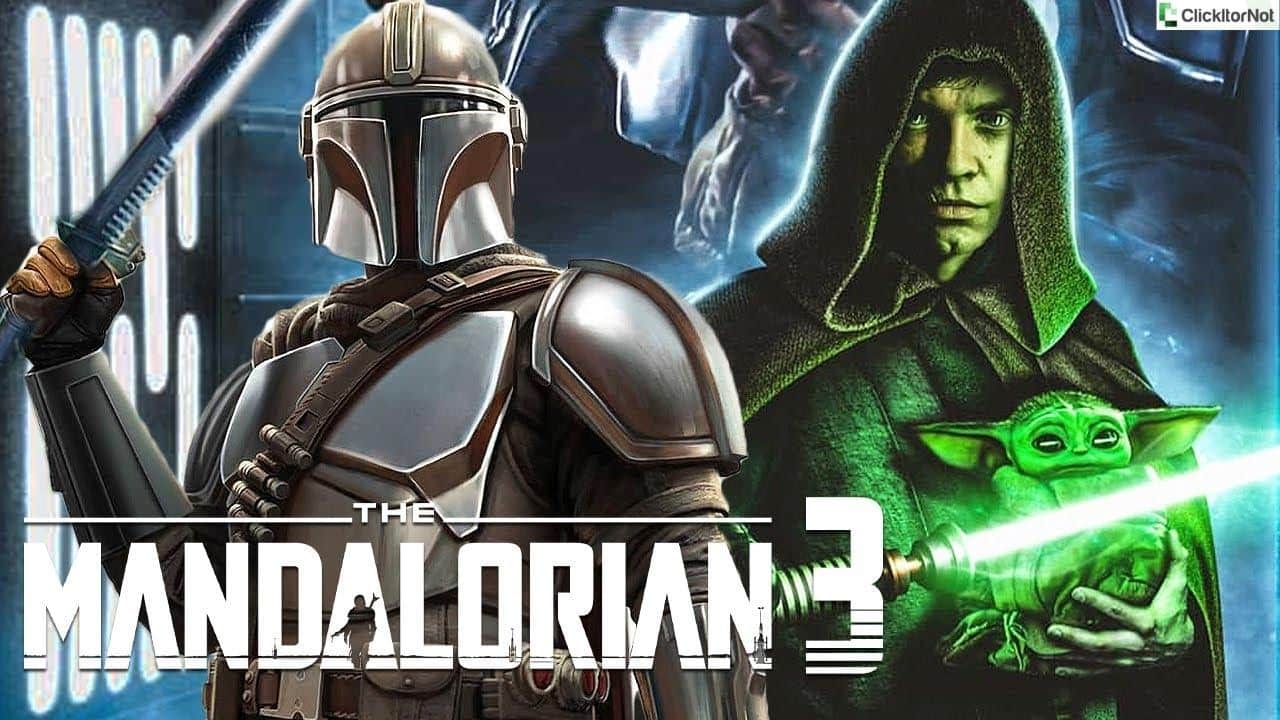In the first chapter of season 3 of The Mandalorian, the titular bounty hunter adopts the young Grogu and shields him from Moff Gideon’s evil plot (Giancarlo Esposito). To finish his training, Grogu was sent to Jedi Master Luke Skywalker (Mark Hamill) by Djarin after leading a group to victory over Gideon.
Jumping straight from the second season-ending to the third season start could leave an audience member perplexed by what they see. Djarin continues to explore the universe. After removing Grogu from the Jedi training school run by Luke Skywalker in between seasons, he still cares for the child.
The Book of Boba Fett’s penultimate episode, “From the Desert Comes a Stranger,” featured this occurrence, but it’s intriguing to consider what viewers who didn’t watch that other show thought of it.
Showrunner Jon Favreau has bragged that he has already finished writing The Mandalorian’s fourth season and thinks the series may go on indefinitely. Disney, the parent business, would undoubtedly be extremely pleased with this.
Disney+’s signature program, The Mandalorian, debuted with the streaming service in December 2019. Nielsen said it was also the most-watched streaming original outside of Netflix in 2020. As a result, it is simple to comprehend why Disney wants to see more of this.
So it seems like The Mandalorian has set off on a rough path toward its third season. The first and second seasons debuted one year apart, but the third season took more than two years to the air. There are several explanations as to why this might have happened.
The crew and equipment used to film Obi-Wan Kenobi were largely the same, and that show’s shooting was notably delayed as scripts were revised.
Pascal himself is a problem as well. While recurrent director Bryce Dallas Howard describes the role as “a real partnership” between Pascal’s voiceover and numerous in-suit performers, including Pascal himself, there is substantial controversy about how much Pascal is truly in The Mandalorian.
Pascal, an actor who stars in The Last of Us on HBO and has other commitments, has praised how the production team for The Mandalorian “improvised” around his schedule.
Season 3 of The Mandalorian is ambiguous, giving the impression that this program has interrupted time. This is represented in a discussion about how much time had elapsed in-universe since Djarin and Grogu first met, which surfaced just before the third season debut.
According to Favreau, the show’s first two seasons spanned “many years,” Grogu was with Skywalker for two years before Djarin picked him up.
Time is relative, of course, and in a science fiction universe with numerous planets with various gravity levels and faster-than-light travel, it is especially elastic.
Even then, the statistics don’t truly correspond to what viewers experienced when watching the events broadcast on television over two years. The exact reason why such statistics don’t “feel” correct is difficult to explain. There is a strange force at work in all of this.
The Mandalorian’s third season premiere, “The Apostate,” continues its uncouthness. It is trapped between three conflicting narrative goals as a television episode.
Assuring the audience that The Mandalorian is back and that it is essentially the same show is the easiest and most immediate. This episode reminds viewers what pleasure it was to watch these two characters engage in silly, pulpy Star Wars adventures.
In season 3, The Mandalorian makes a somewhat awkward return, almost like a reboot, with Din Djarin still in the same spot in his Star Wars adventure.
As a result, “The Apostate” has a thin plot but is packed with generic Star Wars material. By showing the forging of a Mandalorian helmet, the season’s opening sequence welcomes viewers into the mystique of the Mandalorians.
A seven-minute sequence follows, featuring a giant monster attack using lasers and jetpacks. In a later show scene, Djarin engages in combat with space pirates, and a dogfight occurs on an asteroid field. With Djarin and Grogu, it’s all wonderful Star Wars stuff.
The second major goal of the premiere is to update the returning Mandalorian audience on what they missed if they didn’t watch The Book of Boba Fett.
With both the Marvel Cinematic Universe and the Star Wars brand, it seems Disney is beginning to understand the boundaries of these intricately woven shared universes of intersecting shows and that excessive amounts of content are just as likely to alienate mainstream audiences as they are to radicalize them.
Because Marvel couldn’t assume viewers had seen Loki, the character of Kang the Conqueror (Jonathan Majors) had to be introduced twice. The first time, he delivered a lengthy motivational speech after Loki’s first season, and the second time, he did the same after Ant-Man and the Wasp: Quantumania. On the other hand, Josh Brolin’s character, Thanos, only truly had to defend himself once in Avengers: Infinity War.
Djarin’s expulsion from his fellow Mandalorians must be explained by “The Apostate”. There is a lot of duplication.
The Armorer (Emily Swallow) informs Djarin that he is “a Mandalorian no more” because he removed his helmet and that the only place for him to atone for his mistakes is in “the living waters beneath the Mines of Mandalore” in the “previously on” portion of The Book of Boba Fett. In the episode’s opening dialogue with Djarin, she reiterates these identical concerns.
In season 3, The Mandalorian makes a somewhat awkward return, almost like a reboot, with Din Djarin still in the same spot in his Star Wars adventure.
“You’ve taken off your helmet,” she says to Djarin. “You are not a Mandalorian anymore.” It is awkward and unattractive. The intricate and rich mythology of Star Wars has always relied on a lot of “… as you already know… ” exchanges between characters, but in “The Apostate,” characters repeat information that was covered in the episode’s “previously on” just ten minutes earlier. This is prevalent in “The Apostate,” highlighting the foolishness of handing over story pieces to The Book of Boba Fett.
The third competing goal for “The Apostate” is acting as a second pilot for the series, reminding viewers of what they enjoyed about The Mandalorian and catching them up on what they missed in The Book of Boba Fett.
This episode sets out Djarin’s new goals, introduces new rules and stakes, and lays out the general framework for the upcoming season or seasons.
Unfortunately, this entails ending a significant amount of the preceding two seasons’ legend, resulting in exposition regarding what comes before and what lies ahead. There is a quick round of wrapping up the first two seasons when Djarin sees his old friend Karga (Carl Weathers), such as writing out Cara Dune (Gina Carano). Why not mention Marshal Dune? Asks Karga Djarin. Then he asks, “What happened to Gideon?” There is a feeling of having to move swiftly.
The same thing transpires when Djarin visits his former ally Bo-Katan later in the episode (Katee Sackhoff). It resembles a job interview, more than two longtime friends catching up. He asks her about her intentions to recapture Mandalore. Where is the stolen fleet? Does he then ask?
The third season of The Mandalorian doesn’t feel like a direct continuation of the past two. Therefore, much information must be delivered quickly, with little room for poetry or nuance.
Given the conflicting masters that “The Apostate” must serve, it is to Favreau’s credit that it functions at all.
The episode has an almost melancholy undercurrent as Djarin journeys across the galaxy in his antique Naboo starfighter with the student he dragged out of a class, only to find that his old friends had moved on with their lives without him.
The “High Magistrate” Karga is the one who has made Navarro “the diamond of the Outer Rim.” While Katan is alone, at least he is seated on a throne.
Karga seems to be arguing that The Mandalorian’s narrative is finished. He acknowledges, “I’m confused. You finished your task, but you’re still frolicking around with the same critter.
Karga is relishing his retirement and respectability to the extent that Vane (Marti Matulis), an old pirate acquaintance, is taken aback when he learns that Karga turned their former tavern into a school. Karga has grown up since he was younger. He has created a life and a neighborhood.
Karga does extend a comparable invitation to Djarin, implying that the bounty hunter has earned his rest. “You and the little one, you can calm down. You can hang up your blaster,” he advises.
Live off the land’s fat. It’s not a horrible deal, especially considering that The Mandalorian did a lot to restore some credibility to the Star Wars name following the two dud films Solo: A Star Wars Story and Star Wars: The Rise of Skywalker. Is it feasible for Djarin to let go of his responsibilities and proceed?
Djarin appears to still be chasing the past, according to “The Apostate”. IG-11 (Taika Waititi), the assassin droid from the program’s first season, has a broken memory chip, but Djarin still tries to revive it. He tells the Anzellans, “I need this one.
“This is a friend of mine.” For the engineers, Karga translates, “He suggested you should buy a new one.” Djarin is maybe too tied to the past, piloting a Naboo starfighter, striving to maintain the Mandalorian customs, and trying to revive a melted droid.
But, The Mandalorian’s third season, which premieres more than two years after the second one ended, faces this difficulty. Can The Mandalorian be restarted without losing its appeal to fans?
Can it construct a new story and maintain the allure of those first seasons? Is the Way going in one direction, the other, or in circles?









